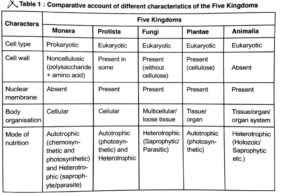Kingdom Systems of Classification
1.Two Kingdom Classification : It was given by Linnaeus. Traditionally all the organisms of the world were divided into two kingdoms- the animal kingdom (Animalia) and the plant kingdom (Plantae). The major criterion of classification was the presence or absence of cell wall. Other criteria’s were locomotion, mode of nutrition, response to external stimuli etc.
Shortcomings of two –kingdom system of classification : Two- kingdom system of classification presented too many inconsistencies. This system did not distinguish between the eukaryotes and prokaryotes, unicelled and multicelled organisms and photosynthetic and non-photosynthetic organisms. There are few organisms like Chlamydomonas, Euglena and the slime moulds which have been claimed by both zoologists and botanists (organisms which share characteristics of both animals and plants). Since there are certain organisms that do not fall naturally into either plant or animal kingdom. It was proposed that a new kingdom is to be established to accommodate such organisms.
2.There Kingdom Classification : Haeckel, a German zoologist (1866), suggested that a third kingdom Protista, be created to include all unicellular microorganisms.
This includes a wide variety of unicellular, mostly aquatic eukaryotes like – Fungi, Protozoa , Algae, Bacteria and slime moulds.
Thus, he proposed three kingdoms, namely – Plantae, Protista and Animalia.
3.Four Kingdom Classification : Copeland (1956) gave four kingdom of classification and included monera as fourth kingdom. Copeland originally called it as kingdom ‘Mychota’. It was called ‘Monera’ by Daugherty and Allen. Kingdom Monera includes all the prokaryotic organisms i.e., eubacteria (including cyanobacteria, formerly known as blue-green algae) and archaebacteria. The actinomycetes (filamentous bacteria) are also included in this kingdom.
4.Five Kingdom Classification : According to five-kingdom concept proposed by R.H. Whittaker (1969), the organism are divided into five kingdoms namely Monera, Protista, Fungi, Plantae, Animalia, on the basis of the following criteria :
- Complexity of cell structure : prokaryotic vs eukaryotic organization of cells.
- Complexity of body organization : unicellularity vs Multicellualrity; simple multicellular forms to complex multicellular forms.
- Mode of nutrition : Autotrophic vs heterotrophic (parasitic or saprobic or ingestive organisms). It was the major criteria of this classification system.
- Reproduction.
- Phylogenetic or evolutionary interrelations

- Six Kingdom Classification : Carl Woese proposed six kingdom classification. These six kingdoms are kingdom-Archaebactera, Kingdom – Eubactera, Kingdom-Protista, Kingdom-Fungi, Kingdom-Plantae and Kingdom-Animalia. He separated the archaebacteria from eubacteria on the basis of some major differences such as the absence of peptidoglycan in the cell walls of the former and the occurrence of branched chain lipids( a monolayer instead of a phospholipid bilayer) in the membrane.
Based on the sequence of 16S ribosomal RNA genes, Woese found that the six kingdoms naturally cluster into three main categories. He called these categories as domains of life. These domains are bacteria, Archae and Eukarya and are believed to have originated from common ancestor called progenote.
